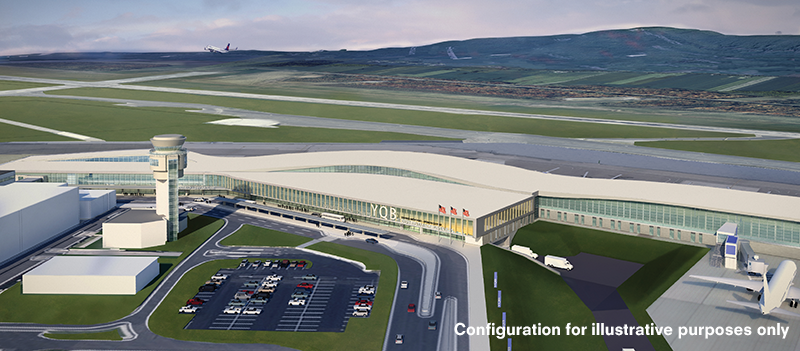A recovery plan to support the economic vitality of the Capitale-Nationale
The YQB team’s mission is clear:
Offer quality, efficient, and secure services and infrastructure capable of sustaining growth in air traffic to consolidate our role as a major socioeconomic force in the greater Québec City area.
This unprecedented global pandemic has grounded planes and emptied airports of passengers in the space of a few months. As such, it has become obvious that Québec City Jean Lesage International Airport (YQB) cannot count on a short-term return of passenger traffic to regain its momentum. The experts all agree: it will take at least five years for passenger traffic to return to 2019 levels. This means that YQB has had to draw on its agility and vision to create a recovery plan that will allow it to chart a new course. In line with its 2020–2025 strategic plan, YQB has prioritized projects that will help it emerge from this crisis on the right footing, equipped with levers to generate growth.
YQB’s recovery plan was developed to achieve the following objectives:
- Contribute to the economic vitality of the Capitale-Nationale area in the short, medium, and long term;
- Lay the groundwork to solidify and develop air service at YQB;
- Reduce YQB’s vulnerability to crises by diversifying the organization’s sources of revenue.
A five-pronged approach
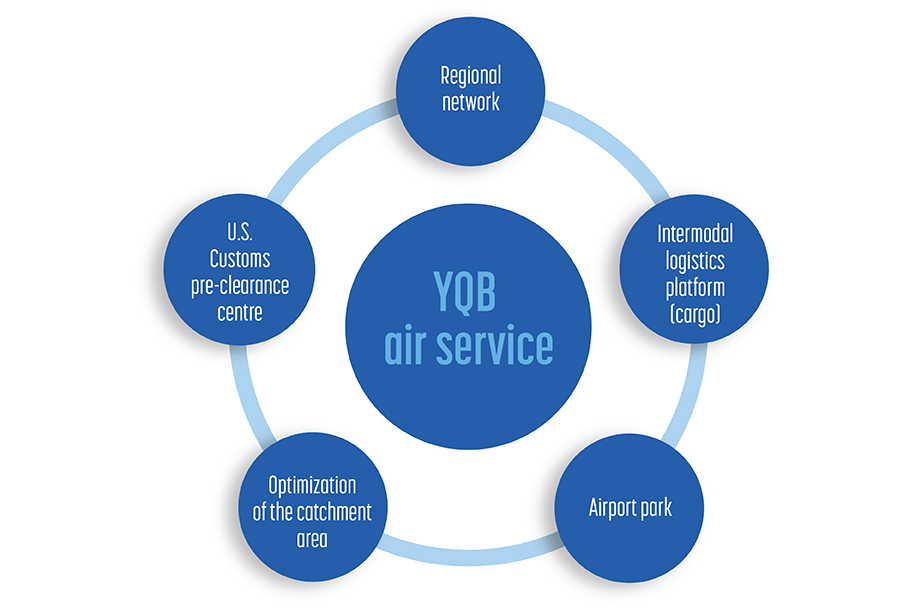
In 2019, YQB had developed its 2020–2025 strategic plan with air development as its focus. Then the global pandemic came along and brought the organization’s momentum to an abrupt halt. But that doesn’t mean it’s going to change its focus. YQB intends to continue to do everything in its power to restore and develop air service from Québec City. In the absence of passengers, YQB is banking on five projects that will act in harmony and serve the interests of both the region and the organization. These projects will generate significant economic benefits, strengthening and improving the economy of the Québec City area.
Optimization of the catchment area
What is a catchment area? It’s the geographical area where an airport’s potential customers are located. In other words, it’s an airport’s market. YQB’s catchment area includes the greater Québec City area, naturally, but also all of northern, eastern, and central Quebec.
Prior to the global COVID-19 pandemic, YQB was losing over one million passengers a year to other airports. That’s no small number, seeing as YQB welcomed nearly 1.8 million passengers in 2019.
While everyone would like more route options, it is important to recognize that carriers will respond if, and only if, they consider a route viable in a given market. More than ever, we must reach out to all potential passengers to develop YQB and maximize its potential.
Optimizing our catchment area isn’t just a goal; it’s an action plan to go after all passengers in a specific market who used to fly out of other areas. This action plan involves tackling several promotional pillars at once to generate results quickly.
Revised parking fees: Parking is a factor in people’s choice of departing airport. YQB has chosen to make this a draw for potential passengers. To that end, the airport changed its parking rates in 2020 in response to passengers’ requests for competitively priced long-term parking.
Incentives for travel agencies: YQB has developed a program to reward travel agencies for referring clients. The program will be launched as soon as passenger traffic recovers.
Distinctive terminal experience: YQB intends to promote initiatives (like events, exhibits, and stores) that create a unique experience for passengers going through the terminal. The goal is for locals and visitors to want to travel through YQB and be fully satisfied with their experience.
Promotional campaigns: As soon as it is appropriate to do so, promotional campaigns will be deployed to encourage people to fly out of YQB.
YQB Catchment area
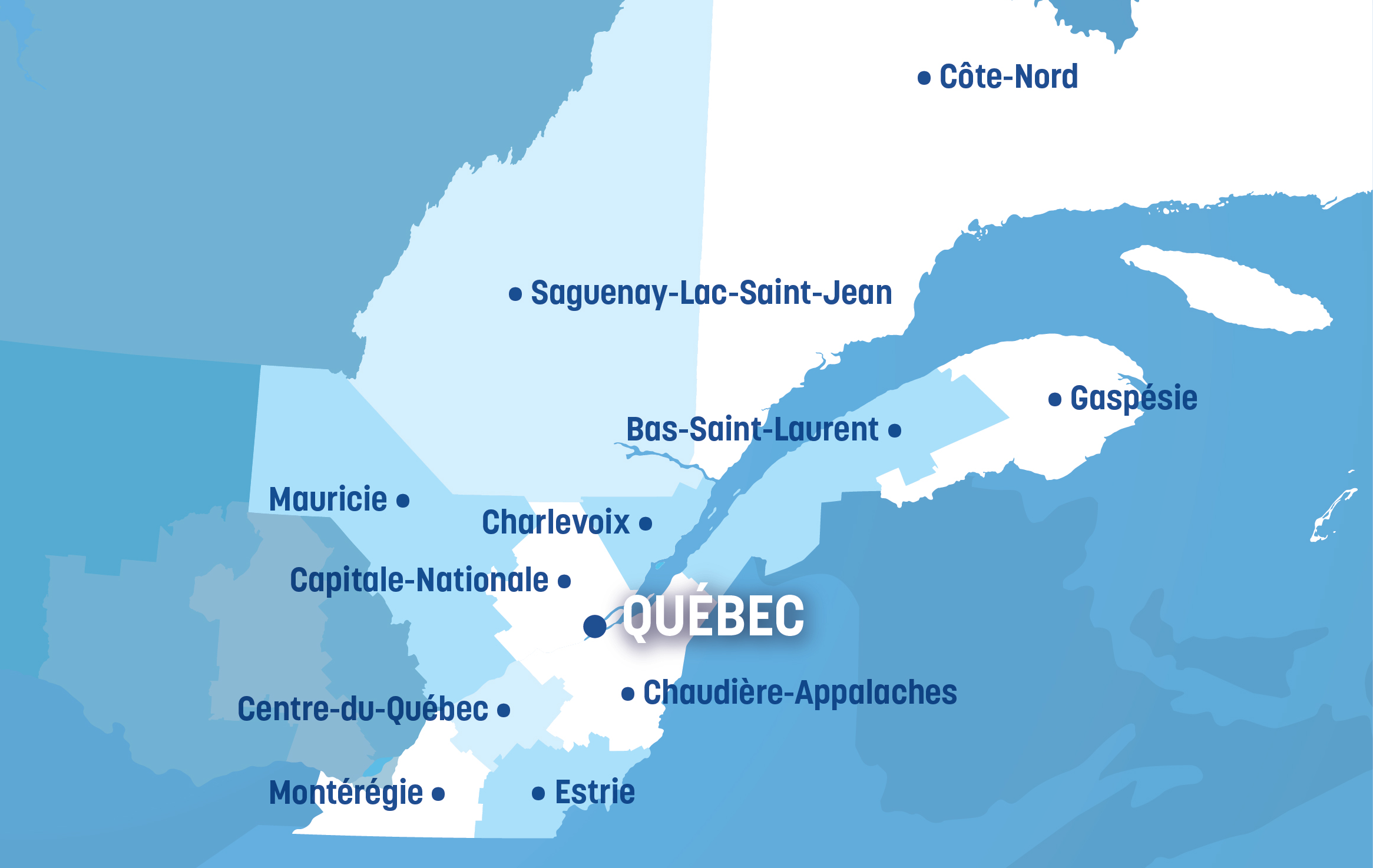
The Secrétariat à la Capitale-Nationale announced in 2020 that YQB would receive $327,000 to support the airport’s recovery, more specifically through the optimization of its catchment area. This funding is a major contribution to the implementation of the first part of the recovery plan.
Consolidation of regional air services
Regional air transportation has been a hot topic in recent years. Flights to more rural areas of Québec are difficult to make profitable in the current market, especially given the business models of most airlines.
In 2020, YQB joined the Groupe d’intervention sur la relance des services aériens régionaux (a task force on the revitalization of regional air services), set up by Québec’s Minister of Transport, François Bonnardel. YQB presented arguments to support Québec City becoming the hub of an optimized regional network, backed by the results of a market study that confirmed the economic viability of this type of service.
The Québec City airport needs this additional traffic to be able to expand its national and international service. YQB already has the infrastructure and equipment to operate a regional network and is actively working with all carriers that are interested in serving that market.
Regional network
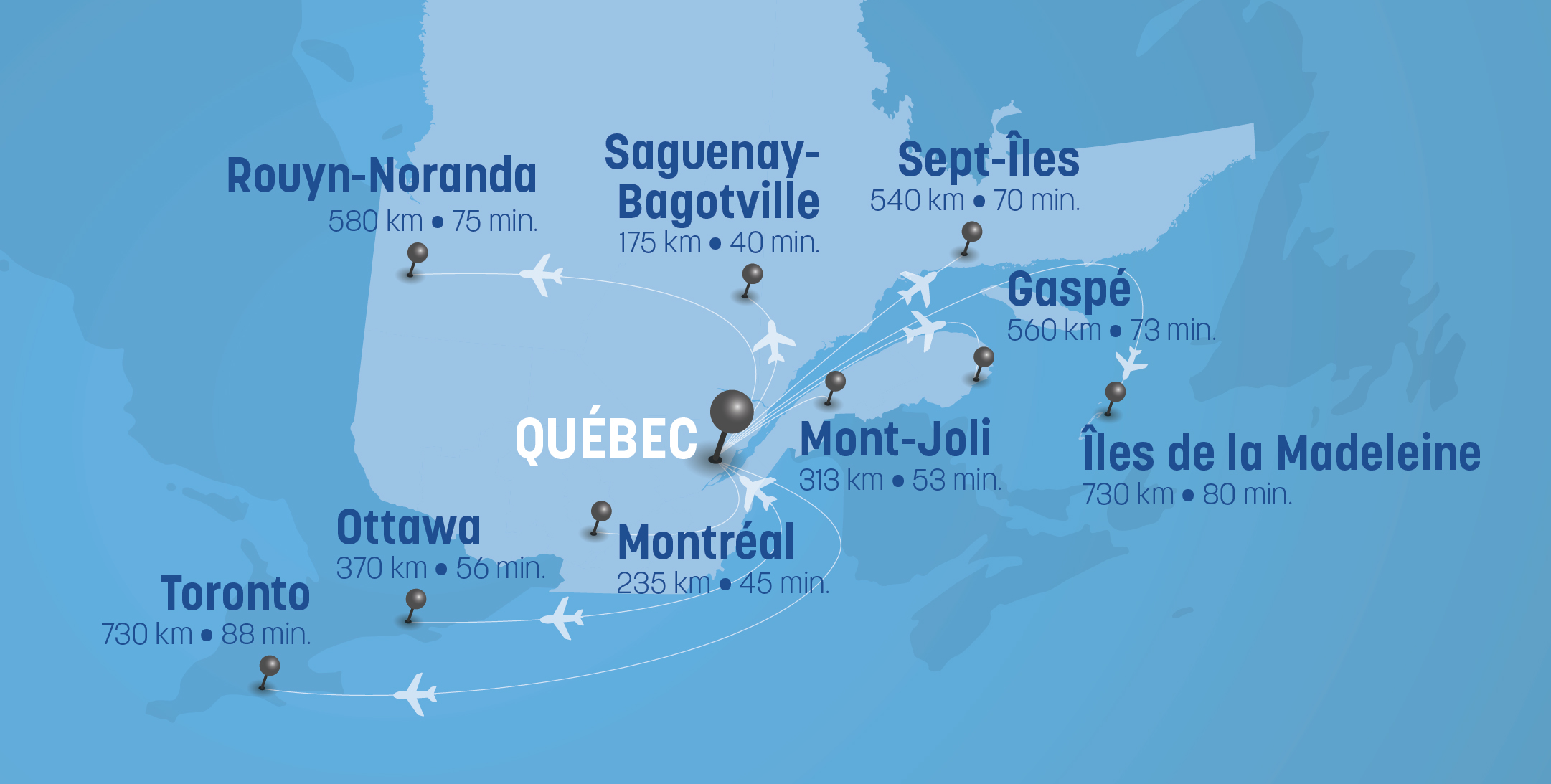
Intermodal logistics platform (cargo)
For airports that have the necessary infrastructure, physical capacity, and logistics platform, airfreight will be a lifeline for emerging stronger from the crisis. Currently, more than 96% of Québec’s air cargo is handled in Montréal. YQB only handles a little over 1%. However, it intends to take advantage of this lifeline, knowing that the airport and the entire Capitale-Nationale region will be left behind if it does not equip itself with the right infrastructure. Especially since consumers’ reliance on online shopping, which was accentuated by the pandemic, is here to stay.
For that reason, one project involves building an intermodal airfreight centre at YQB itself so that goods can be transported by air or truck, then transshipped. In doing so, YQB will be taking advantage of an opportunity to emerge from this crisis while taking advantage of the growth of this market and diversifying its sources of revenue. This trend of diversifying activities and sources of revenue is widespread among airport companies. Given that passenger flights will recover slowly, the financial contributions of airfreight will be essential to the viability of routes. Airlines could use the YQB intermodal airfreight centre to transport air cargo in the hold. This would help make their passenger flights more profitable, which in turn would increase the number of new services.
YQB’s intermodal airfreight centre will also support the development of industrial sectors with time-sensitive delivery needs, not just in Québec City, but in northern and eastern Québec as well. Businesses in these industries include:
- Manufacturers of electronic, optical, and photonic products;
- Pharmaceutical and life sciences companies;
- Producers and wholesalers of organic food products;
- Fish shops in the Bas-Saint-Laurent and Gaspésie regions;
- Online merchants (retailers, hardware stores, etc.);
- Distributors of equipment parts.
Our region’s most promising industries are competing on a global scale, so state-of-the-art airfreight facilities are a must for them. Additionally, online retailers are increasingly focusing on extremely fast delivery times, and an airfreight centre is particularly well suited to this type of service. Finally, airfreight would open up new opportunities for economic growth in the Québec City area as well as northern and eastern Québec.
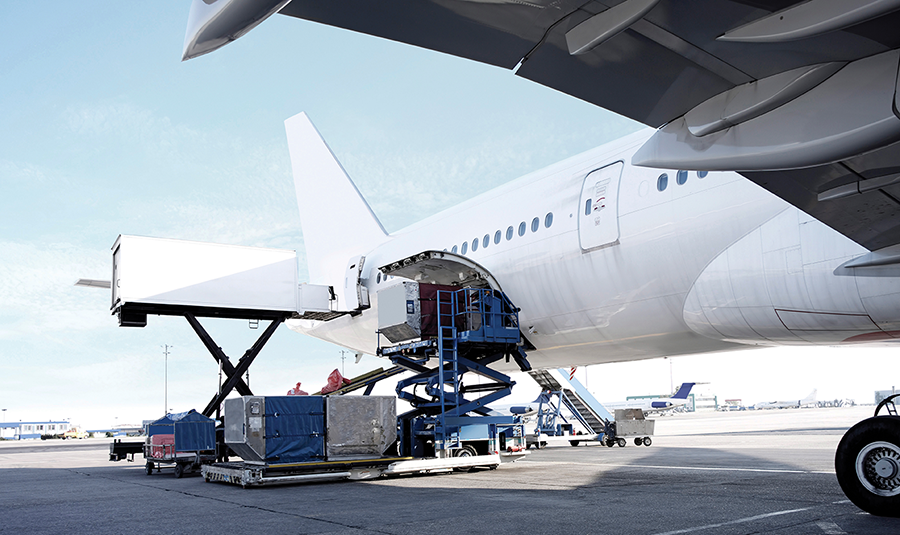
Airport park
The airport park project involves developing 1.2 million square metres of land in the heart of the provincial capital. This offer becomes crucial in a context where almost all of the region’s industrial parks are full.
For YQB, this is a remarkable opportunity to diversify its revenue. Land lease payments will reduce the financial pressure on the aviation business and mitigate risk in the event of another air transportation crisis.
The project requires available land to be developed by adding surface and underground infrastructures. It will be rolled out in three phases over several years. As part of Phase 1, YQB is ready to welcome potential tenants now.
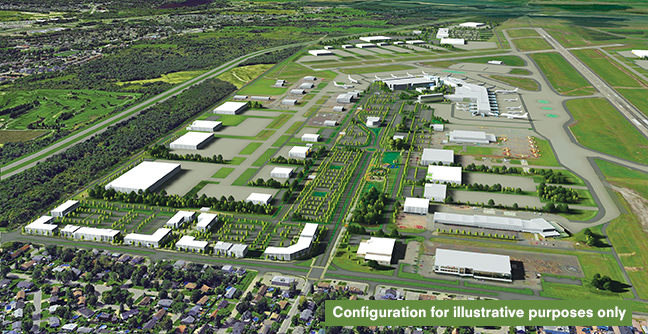
U.S. Customs
pre-clearance centre
Creating a pre-clearance centre has always been a must for the Québec City airport’s long-term development. This project has the support of 95% of the community and all of the region’s economic partners. They are eager to see this project start soon, as it will have a significant impact on cross-border traffic in the coming years.
Of course, given the nature of the pandemic, the air transportation industry will not recover as fast as other industries; this crisis will impact our passenger traffic for several years to come. However, this project will remain crucial to the vitality and attractiveness of our region in the medium and long term.
The ability for passengers to clear U.S. customs when flying out of Canada is a real lever of development for the Québec City region and all of YQB’s catchment area. The service would allow for new cross-border destinations, which in turn would bring significantly more business and leisure passengers through YQB.
